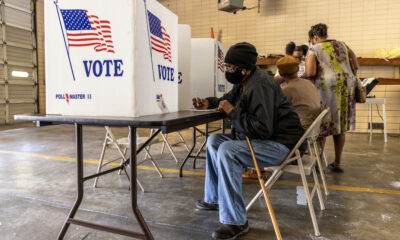Kaiser Health News
Extra Fees Drive Assisted Living Profits

Jordan Rau, KFF Health News
Mon, 20 Nov 2023 10:00:00 +0000
Assisted living centers have become an appealing retirement option for hundreds of thousands of boomers who can no longer live independently, promising a cheerful alternative to the institutional feel of a nursing home.
But their cost is so crushingly high that most Americans can’t afford them.
These highly profitable facilities often charge $5,000 a month or more and then layer on fees at every step. Residents’ bills and price lists from a dozen facilities offer a glimpse of the charges: $12 for a blood pressure check; $50 per injection (more for insulin); $93 a month to order medications from a pharmacy not used by the facility; $315 a month for daily help with an inhaler.
The facilities charge extra to help residents get to the shower, bathroom, or dining room; to deliver meals to their rooms; to have staff check-ins for daily “reassurance” or simply to remind residents when it’s time to eat or take their medication. Some even charge for routine billing of a resident’s insurance for care.
“They say, ‘Your mother forgot one time to take her medications, and so now you’ve got to add this on, and we’re billing you for it,’” said Lori Smetanka, executive director of the National Consumer Voice for Quality Long-Term Care, a nonprofit.
About 850,000 older Americans reside in assisted living facilities, which have become one of the most lucrative branches of the long-term care industry that caters to people 65 and older. Investors, regional companies, and international real estate trusts have jumped in: Half of operators in the business of assisted living earn returns of 20% or more than it costs to run the sites, an industry survey shows. That is far higher than the money made in most other health sectors.
Rents are often rivaled or exceeded by charges for services, which are either packaged in a bundle or levied à la carte. Overall prices have been rising faster than inflation, and rent increases since the start of last year have been higher than at any previous time since at least 2007, according to the National Investment Center for Seniors Housing & Care, which provides data and other information to companies.
There are now 31,000 assisted living facilities nationwide — twice the number of skilled nursing homes. Four of every five facilities are run as for-profits. Members of racial or ethnic minority groups account for only a tenth of residents, even though they make up a quarter of the population of people 65 or older in the United States.
A public opinion survey conducted by KFF found that 83% of adults said it would be impossible or very difficult to pay $60,000 a year for an assisted living facility. Almost half of those surveyed who either lived in a long-term care residence or had a loved one who did encountered unexpected add-on fees for things they assumed were included in the price.
Assisted living is part of a broader affordability crisis in long-term care for the swelling population of older Americans. Over the past decade, the market for long-term care insurance has virtually collapsed, covering just a tiny portion of older people. Home health workers who can help people stay safely in their homes are generally poorly paid and hard to find.
And even older people who can afford an assisted living facility often find their life savings rapidly drained.
Unlike most residents of nursing homes, where care is generally paid for by Medicaid, the federal-state program for the poor and disabled, assisted living residents or their families usually must shoulder the full costs. Most centers require those who can no longer pay to move out.
The industry says its pricing structures pay for increased staffing that helps the more infirm residents and avoids saddling others with costs of services they don’t need.
Prices escalate greatly when a resident develops dementia or other serious illnesses. At one facility in California, the monthly cost of care packages for people with dementia or other cognitive issues increased from $1,325 for those needing the least amount of help to $4,625 as residents’ needs grew.
“It’s profiteering at its worst,” said Mark Bonitz, who explored multiple places in Minnesota for his mother, Elizabeth. “They have a fixed amount of rooms,” he said. “The way you make the most money is you get so many add-ons.” Last year, he moved his mother to a nonprofit center, where she lived until her death in July at age 96.
LaShuan Bethea, executive director of the National Center for Assisted Living, a trade association of owners and operators, said the industry would require financial support from the government and private lenders to bring prices down.
“Assisted living providers are ready and willing to provide more affordable options, especially for a growing elderly population,” Bethea said. “But we need the support of policymakers and other industries.” She said offering affordable assisted living “requires an entirely different business model.”
Others defend the extras as a way to appeal to the waves of boomers who are retiring. “People want choice,” said Beth Burnham Mace, a special adviser for the National Investment Center for Seniors Housing & Care. “If you price it more à la carte, you’re paying for what you actually desire and need.”
Yet residents don’t always get the heightened attention they paid for. Class-action lawsuits have accused several assisted living chains of failing to raise staffing levels to accommodate residents’ needs or of failing to fulfill billed services.
“We still receive many complaints about staffing shortages and services not being provided as promised,” said Aisha Elmquist, until recently the deputy ombudsman for long-term care in Minnesota, a state-funded advocate. “Some residents have reported to us they called 911 for things like getting in and out of bed.”
‘Can You Find Me a Money Tree?’
Florence Reiners, 94, adores living at the Waters of Excelsior, an upscale assisted living facility in the Minneapolis suburb of Excelsior. The 115-unit building has a theater, a library, a hair salon, and a spacious dining room.
“The windows, the brightness, and the people overall are very cheerful and very friendly,” Reiners, a retired nursing assistant, said. Most important, she was just a floor away from her husband, Donald, 95, a retired water department worker who served in the military after World War II and has severe dementia.
She resisted her children’s pleas to move him to a less expensive facility available to veterans.
Reiners is healthy enough to be on a floor for people who can live independently, so her rent is $3,330 plus $275 for a pendant alarm. When she needs help, she’s billed an exact amount, like a $26.67 charge for the 31 minutes an aide spent helping her to the bathroom one night.
Her husband’s specialty care at the facility cost much more: $6,150 a month on top of $3,825 in rent.
Month by month, their savings, mainly from the sale of their home, and monthly retirement income of $6,600 from Social Security and his municipal pension, dwindled. In three years, their assets and savings dropped to about $300,000 from around $550,000.
Her children warned her that she would run out of money if her health worsened. “She about cried because she doesn’t want to leave her community,” Anne Palm, one of her daughters, said.
In June, they moved Donald Reiners to the VA home across the city. His care there costs $3,900 a month, 60% less than at the Waters. But his wife is not allowed to live at the veterans’ facility.
After nearly 60 years together, she was devastated. When an admissions worker asked her if she had any questions, she answered, “Can you find me a money tree so I don’t have to move him?”
Heidi Elliott, vice president for operations at the Waters, said employees carefully review potential residents’ financial assets with them, and explain how costs can increase over time.
“Oftentimes, our senior living consultants will ask, ‘After you’ve reviewed this, Mr. Smith, how many years do you think Mom is going to be able to, to afford this?’” she said. “And sometimes we lose prospects because they’ve realized, ‘You know what? Nope, we don’t have it.’”
Potential Buyers From the Bahamas
For residents, the median annual price of assisted living has increased 31% faster than inflation, nearly doubling from 2004 to 2021, to $54,000, according to surveys by the insurance firm Genworth. Monthly fees at memory care centers, which specialize in people with dementia and other cognitive issues, can exceed $10,000 in areas where real estate is expensive or the residents’ needs are high.
Diane Lepsig, president of CarePatrol of Bellevue-Eastside, in the Seattle suburbs, which helps place people, said that she has warned those seeking advice that they should expect to pay at least $7,000 a month. “A million dollars in assets really doesn’t last that long,” she said.
Prices rose even faster during the pandemic as wages and supply costs grew. Brookdale Senior Living, one of the nation’s largest assisted living owners and operators, reported to stockholders rate increases that were higher than usual for this year. In its assisted living and memory care division, Brookdale’s revenue per occupied unit rose 9.4% in 2023 from 2022, primarily because of rent increases, financial disclosures show.
In a statement, Brookdale said it worked with prospective residents and their families to explain the pricing and care options available: “These discussions begin in the initial stages of moving in but also continue throughout the span that one lives at a community, especially as their needs change.”
Many assisted living facilities are owned by real estate investment trusts. Their shareholders expect the high returns that are typically gained from housing investments rather than the more marginal profits of the heavily regulated health care sector. Even during the pandemic, earnings remained robust, financial filings show.
Ventas, a publicly traded real estate investment trust, reported earning revenues in the third quarter of this year that were 24% above operating costs from its investments in 576 senior housing properties, which include those run by Atria Senior Living and Sunrise Senior Living.
Ventas said the prices for its services were affordable. “In markets where we operate, on average it costs residents a comparable amount to live in our communities as it does to stay in their own homes and replicate services,” said Molly McEvily, a spokesperson.
In the same period, Welltower, another large real estate investment trust, reported a 24% operating margin from its 883 senior housing properties, which include ones operated by Sunrise, Atria, Oakmont Management Group, and Belmont Village. Welltower did not respond to requests for comment.
The median operating margin for assisted living facilities in 2021 was 23% if they offered memory care and 20% if they didn’t, according to David Schless, chief executive of the American Seniors Housing Association, a trade group that surveys the industry each year.
Bethea said those returns could be invested back into facilities’ services, technology, and building updates. “This is partly why assisted living also enjoys high customer satisfaction rates,” she said.
Brandon Barnes, an administrator at a family business that owns three small residences in Esko, Minnesota, said he and other small operators had been approached by brokers for companies, including one based in the Bahamas. “I don’t even know how you’d run them from that far away,” he said.
Rating the Cost of a Shower, on a Point Scale
To consistently get such impressive returns, some assisted living facilities have devised sophisticated pricing methods. Each service is assigned points based on an estimate of how much it costs in extra labor, to the minute. When residents arrive, they are evaluated to see what services they need, and the facility adds up the points. The number of points determines which tier of services you require; facilities often have four or five levels of care, each with its own price.
Charles Barker, an 81-year-old retired psychiatrist with Alzheimer’s, moved into Oakmont of Pacific Beach, a memory care facility in San Diego, in November 2020. In the initial estimate, he was assigned 135 points: 5 for mealtime reminders; 12 for shaving and grooming reminders; 18 for help with clothes selection twice a day; 36 to manage medications; and 30 for the attention, prompting, and redirection he would need because of his dementia, according to a copy of his assessment provided by his daughter, Celenie Singley.
Barker’s points fell into the second-lowest of five service levels, with a charge of $2,340 on top of his $7,895 monthly rent.
Singley became distraught over safety issues that she said did not seem as important to Oakmont as its point system. She complained in a May 2021 letter to Courtney Siegel, the company’s chief executive, that she repeatedly found the doors to the facility, located on a busy street, unlocked — a lapse at memory care centers, where secured exits keep people with dementia from wandering away. “Even when it’s expensive, you really don’t know what you’re getting,” she said in an interview.
Singley, 50, moved her father to another memory care unit. Oakmont did not respond to requests for comment.
Other residents and their families brought a class-action lawsuit against Oakmont in 2017 that said the company, an assisted living and memory care provider based in Irvine, California, had not provided enough staffing to meet the needs of residents it identified through its own assessments.
Jane Burton-Whitaker, a plaintiff who moved into Oakmont of Mariner Point in Alameda, California, in 2016, paid $5,795 monthly rent and $270 a month for assistance with her urinary catheter, but sometimes the staff would empty the bag just once a day when it required multiple changes, the lawsuit said.
She paid an additional $153 a month for checks of her “fragile” skin “up to three times a day, but most days staff did not provide any skin checks,” according to the lawsuit. (Skin breakdown is a hazard for older people that can lead to bedsores and infections.) Sometimes it took the staff 45 minutes to respond to her call button, so she left the facility in 2017 out of concern she would not get attention should she have a medical emergency, the lawsuit said.
Oakmont paid $9 million in 2020 to settle the class-action suit and agreed to provide enough staffing, without admitting fault.
Similar cases have been brought against other assisted living companies. In 2021, Aegis Living, a company based in Bellevue, Washington, agreed to a $16 million settlement in a case claiming that its point system — which charged 64 cents per point per day — was “based solely on budget considerations and desired profit margins.” Aegis did not admit fault in the settlement or respond to requests for comment.
When the Money Is Gone
Jon Guckenberg’s rent for a single room in an assisted living cottage in rural Minnesota was $4,140 a month before adding in a raft of other charges.
The facility, New Perspective Cloquet, charged him $500 to reserve a spot and a $2,000 “entrance fee” before he set foot inside two years ago. Each month, he also paid $1,080 for a care plan that helped him cope with bipolar disorder and kidney problems, $750 for meals, and another $750 to make sure he took his daily medications. Cable service in his room was an extra $50 a month.
A year after moving in, Guckenberg, 83, a retired pizza parlor owner, had run through his life’s savings and was put on a state health plan for the poor.
Doug Anderson, a senior vice president at New Perspective, said in a statement that “the cost and complexity of providing care and housing to seniors has increased exponentially due to the pandemic and record-high inflation.”
In one way, Guckenberg has been luckier than most people who run out of money to pay for their care. His residential center accepts Medicaid to cover the health services he receives.
Most states have similar programs, though a resident must be frail enough to qualify for a nursing home before Medicaid will cover the health care costs in an assisted living facility. But enrollment is restricted. In 37 states, people are on waiting lists for months or years.
“We recognize the current system of having residents spend down their assets and then qualify for Medicaid in order to stay in their assisted living home is broken,” said Bethea, with the trade association. “Residents shouldn’t have to impoverish themselves in order to continue receiving assisted living care.”
Only 18% of residential care facilities agree to take Medicaid payments, which tend to be lower than what they charge self-paying clients, according to a federal survey of facilities. And even places that accept Medicaid often limit coverage to a minority of their beds.
For those with some retirement income, Medicaid isn’t free. Nancy Pilger, Guckenberg’s guardian, said that he was able to keep only about $200 of his $2,831 monthly retirement income, with the rest going to paying rent and a portion of his costs covered by the government.
In September, Guckenberg moved to a nearby assisted living building run by a nonprofit. Pilger said the price was the same. But for other residents who have not yet exhausted their assets, Guckenberg’s new home charges $12 a tray for meal delivery to the room; $50 a month to bill a person’s long-term care insurance plan; and $55 for a set of bed rails.
Even after Guckenberg had left New Perspective, however, the company had one more charge for him: a $200 late payment fee for money it said he still owed.
——————————
By: Jordan Rau, KFF Health News
Title: Extra Fees Drive Assisted Living Profits
Sourced From: kffhealthnews.org/news/article/dying-broke-extra-fees-drive-assisted-living-profits/
Published Date: Mon, 20 Nov 2023 10:00:00 +0000
Kaiser Health News
US Judge Names Receiver To Take Over California Prisons’ Mental Health Program

SACRAMENTO, Calif. — A judge has initiated a federal court takeover of California’s troubled prison mental health system by naming the former head of the Federal Bureau of Prisons to serve as receiver, giving her four months to craft a plan to provide adequate care for tens of thousands of prisoners with serious mental illness.
Senior U.S. District Judge Kimberly Mueller issued her order March 19, identifying Colette Peters as the nominated receiver. Peters, who was Oregon’s first female corrections director and known as a reformer, ran the scandal-plagued federal prison system for 30 months until President Donald Trump took office in January. During her tenure, she closed a women’s prison in Dublin, east of Oakland, that had become known as the “rape club.”
Michael Bien, who represents prisoners with mental illness in the long-running prison lawsuit, said Peters is a good choice. Bien said Peters’ time in Oregon and Washington, D.C., showed that she “kind of buys into the fact that there are things we can do better in the American system.”
“We took strong objection to many things that happened under her tenure at the BOP, but I do think that this is a different job and she’s capable of doing it,” said Bien, whose firm also represents women who were housed at the shuttered federal women’s prison.
California corrections officials called Peters “highly qualified” in a statement, while Gov. Gavin Newsom’s office did not immediately comment. Mueller gave the parties until March 28 to show cause why Peters should not be appointed.
Peters is not talking to the media at this time, Bien said. The judge said Peters is to be paid $400,000 a year, prorated for the four-month period.
About 34,000 people incarcerated in California prisons have been diagnosed with serious mental illnesses, representing more than a third of California’s prison population, who face harm because of the state’s noncompliance, Mueller said.
Appointing a receiver is a rare step taken when federal judges feel they have exhausted other options. A receiver took control of Alabama’s correctional system in 1976, and they have otherwise been used to govern prisons and jails only about a dozen times, mostly to combat poor conditions caused by overcrowding. Attorneys representing inmates in Arizona have asked a judge to take over prison health care there.
Mueller’s appointment of a receiver comes nearly 20 years after a different federal judge seized control of California’s prison medical system and installed a receiver, currently J. Clark Kelso, with broad powers to hire, fire, and spend the state’s money.
California officials initially said in August that they would not oppose a receivership for the mental health program provided that the receiver was also Kelso, saying then that federal control “has successfully transformed medical care” in California prisons. But Kelso withdrew from consideration in September, as did two subsequent candidates. Kelso said he could not act “zealously and with fidelity as receiver in both cases.”
Both cases have been running for so long that they are now overseen by a second generation of judges. The original federal judges, in a legal battle that reached the U.S. Supreme Court, more than a decade ago forced California to significantly reduce prison crowding in a bid to improve medical and mental health care for incarcerated people.
State officials in court filings defended their improvements over the decades. Prisoners’ attorneys countered that treatment remains poor, as evidenced in part by the system’s record-high suicide rate, topping 31 suicides per 100,000 prisoners, nearly double that in federal prisons.
“More than a quarter of the 30 class-members who died by suicide in 2023 received inadequate care because of understaffing,” prisoners’ attorneys wrote in January, citing the prison system’s own analysis. One prisoner did not receive mental health appointments for seven months “before he hanged himself with a bedsheet.”
They argued that the November passage of a ballot measure increasing criminal penalties for some drug and theft crimes is likely to increase the prison population and worsen staffing shortages.
California officials argued in January that Mueller isn’t legally justified in appointing a receiver because “progress has been slow at times but it has not stalled.”
Mueller has countered that she had no choice but to appoint an outside professional to run the prisons’ mental health program, given officials’ intransigence even after she held top officials in contempt of court and levied fines topping $110 million in June. Those extreme actions, she said, only triggered more delays.
The 9th U.S. Circuit Court of Appeals on March 19 upheld Mueller’s contempt ruling but said she didn’t sufficiently justify calculating the fines by doubling the state’s monthly salary savings from understaffing prisons. It upheld the fines to the extent that they reflect the state’s actual salary savings but sent the case back to Mueller to justify any higher penalty.
Mueller had been set to begin additional civil contempt proceedings against state officials for their failure to meet two other court requirements: adequately staffing the prison system’s psychiatric inpatient program and improving suicide prevention measures. Those could bring additional fines topping tens of millions of dollars.
But she said her initial contempt order has not had the intended effect of compelling compliance. Mueller wrote as far back as July that additional contempt rulings would also be likely to be ineffective as state officials continued to appeal and seek delays, leading “to even more unending litigation, litigation, litigation.”
She went on to foreshadow her latest order naming a receiver in a preliminary order: “There is one step the court has taken great pains to avoid. But at this point,” Mueller wrote, “the court concludes the only way to achieve full compliance in this action is for the court to appoint its own receiver.”
This article was produced by KFF Health News, which publishes California Healthline, an editorially independent service of the California Health Care Foundation.
If you or someone you know may be experiencing a mental health crisis, contact the 988 Suicide & Crisis Lifeline by dialing or texting “988.”
The post US Judge Names Receiver To Take Over California Prisons’ Mental Health Program appeared first on kffhealthnews.org
Kaiser Health News
Amid Plummeting Diversity at Medical Schools, a Warning of DEI Crackdown’s ‘Chilling Effect’

The Trump administration’s crackdown on DEI programs could exacerbate an unexpectedly steep drop in diversity among medical school students, even in states like California, where public universities have been navigating bans on affirmative action for decades. Education and health experts warn that, ultimately, this could harm patient care.
Since taking office, President Donald Trump has issued a handful of executive orders aimed at terminating all diversity, equity, and inclusion, or DEI, initiatives in federally funded programs. And in his March 4 address to Congress, he described the Supreme Court’s 2023 decision banning the consideration of race in college and university admissions as “brave and very powerful.”
Last month, the Education Department’s Office for Civil Rights — which lost about 50% of its staff in mid-March — directed schools, including postsecondary institutions, to end race-based programs or risk losing federal funding. The “Dear Colleague” letter cited the Supreme Court’s decision.
Paulette Granberry Russell, president and CEO of the National Association of Diversity Officers in Higher Education, said that “every utterance of ‘diversity’ is now being viewed as a violation or considered unlawful or illegal.” Her organization filed a lawsuit challenging Trump’s anti-DEI executive orders.
While California and eight other states — Arizona, Florida, Idaho, Michigan, Nebraska, New Hampshire, Oklahoma, and Washington — had already implemented bans of varying degrees on race-based admissions policies well before the Supreme Court decision, schools bolstered diversity in their ranks with equity initiatives such as targeted scholarships, trainings, and recruitment programs.
But the court’s decision and the subsequent state-level backlash — 29 states have since introduced bills to curb diversity initiatives, according to data published by the Chronicle of Higher Education — have tamped down these efforts and led to the recent declines in diversity numbers, education experts said.
After the Supreme Court’s ruling, the numbers of Black and Hispanic medical school enrollees fell by double-digit percentages in the 2024-25 school year compared with the previous year, according to the Association of American Medical Colleges. Black enrollees declined 11.6%, while the number of new students of Hispanic origin fell 10.8%. The decline in enrollment of American Indian or Alaska Native students was even more dramatic, at 22.1%. New Native Hawaiian or other Pacific Islander enrollment declined 4.3%.
“We knew this would happen,” said Norma Poll-Hunter, AAMC’s senior director of workforce diversity. “But it was double digits — much larger than what we anticipated.”
The fear among educators is the numbers will decline even more under the new administration.
At the end of February, the Education Department launched an online portal encouraging people to “report illegal discriminatory practices at institutions of learning,” stating that students should have “learning free of divisive ideologies and indoctrination.” The agency later issued a “Frequently Asked Questions” document about its new policies, clarifying that it was acceptable to observe events like Black History Month but warning schools that they “must consider whether any school programming discourages members of all races from attending.”
“It definitely has a chilling effect,” Poll-Hunter said. “There is a lot of fear that could cause institutions to limit their efforts.”
Numerous requests for comment from medical schools about the impact of the anti-DEI actions went unreturned. University presidents are staying mum on the issue to protect their institutions, according to reporting from The New York Times.
Utibe Essien, a physician and UCLA assistant professor, said he has heard from some students who fear they won’t be considered for admission under the new policies. Essien, who co-authored a study on the effect of affirmative action bans on medical schools, also said students are worried medical schools will not be as supportive toward students of color as in the past.
“Both of these fears have the risk of limiting the options of schools folks apply to and potentially those who consider medicine as an option at all,” Essien said, adding that the “lawsuits around equity policies and just the climate of anti-diversity have brought institutions to this place where they feel uncomfortable.”
In early February, the Pacific Legal Foundation filed a lawsuit against the University of California-San Francisco’s Benioff Children’s Hospital Oakland over an internship program designed to introduce “underrepresented minority high school students to health professions.”
Attorney Andrew Quinio filed the suit, which argues that its plaintiff, a white teenager, was not accepted to the program after disclosing in an interview that she identified as white.
“From a legal standpoint, the issue that comes about from all this is: How do you choose diversity without running afoul of the Constitution?” Quinio said. “For those who want diversity as a goal, it cannot be a goal that is achieved with discrimination.”
UC Health spokesperson Heather Harper declined to comment on the suit on behalf of the hospital system.
Another lawsuit filed in February accuses the University of California of favoring Black and Latino students over Asian American and white applicants in its undergraduate admissions. Specifically, the complaint states that UC officials pushed campuses to use a “holistic” approach to admissions and “move away from objective criteria towards more subjective assessments of the overall appeal of individual candidates.”
The scrutiny of that approach to admissions could threaten diversity at the UC-Davis School of Medicine, which for years has employed a “race-neutral, holistic admissions model” that reportedly tripled enrollment of Black, Latino, and Native American students.
“How do you define diversity? Does it now include the way we consider how someone’s lived experience may be influenced by how they grew up? The type of school, the income of their family? All of those are diversity,” said Granberry Russell, of the National Association of Diversity Officers in Higher Education. “What might they view as an unlawful proxy for diversity equity and inclusion? That’s what we’re confronted with.”
California Attorney General Rob Bonta, a Democrat, recently joined other state attorneys general to issue guidance urging that schools continue their DEI programs despite the federal messaging, saying that legal precedent allows for the activities. California is also among several states suing the administration over its deep cuts to the Education Department.
If the recent decline in diversity among newly enrolled students holds or gets worse, it could have long-term consequences for patient care, academic experts said, pointing toward the vast racial disparities in health outcomes in the U.S., particularly for Black people.
A higher proportion of Black primary care doctors is associated with longer life expectancy and lower mortality rates among Black people, according to a 2023 study published by the JAMA Network.
Physicians of color are also more likely to build their careers in medically underserved communities, studies have shown, which is increasingly important as the AAMC projects a shortage of up to 40,400 primary care doctors by 2036.
“The physician shortage persists, and it’s dire in rural communities,” Poll-Hunter said. “We know that diversity efforts are really about improving access for everyone. More diversity leads to greater access to care — everyone is benefiting from it.”
This article was produced by KFF Health News, which publishes California Healthline, an editorially independent service of the California Health Care Foundation.
The post Amid Plummeting Diversity at Medical Schools, a Warning of DEI Crackdown’s ‘Chilling Effect’ appeared first on kffhealthnews.org
Kaiser Health News
Tribal Health Leaders Say Medicaid Cuts Would Decimate Health Programs

As Congress mulls potentially massive cuts to federal Medicaid funding, health centers that serve Native American communities, such as the Oneida Community Health Center near Green Bay, Wisconsin, are bracing for catastrophe.
That’s because more than 40% of the about 15,000 patients the center serves are enrolled in Medicaid. Cuts to the program would be detrimental to those patients and the facility, said Debra Danforth, the director of the Oneida Comprehensive Health Division and a citizen of the Oneida Nation.
“It would be a tremendous hit,” she said.
The facility provides a range of services to most of the Oneida Nation’s 17,000 people, including ambulatory care, internal medicine, family practice, and obstetrics. The tribe is one of two in Wisconsin that have an “open-door policy,” Danforth said, which means that the facility is open to members of any federally recognized tribe.
But Danforth and many other tribal health officials say Medicaid cuts would cause service reductions at health facilities that serve Native Americans.
Indian Country has a unique relationship to Medicaid, because the program helps tribes cover chronic funding shortfalls from the Indian Health Service, the federal agency responsible for providing health care to Native Americans.
Medicaid has accounted for about two-thirds of third-party revenue for tribal health providers, creating financial stability and helping facilities pay operational costs. More than a million Native Americans enrolled in Medicaid or the closely related Children’s Health Insurance Program also rely on the insurance to pay for care outside of tribal health facilities without going into significant medical debt. Tribal leaders are calling on Congress to exempt tribes from cuts and are preparing to fight to preserve their access.
“Medicaid is one of the ways in which the federal government meets its trust and treaty obligations to provide health care to us,” said Liz Malerba, director of policy and legislative affairs for the United South and Eastern Tribes Sovereignty Protection Fund, a nonprofit policy advocacy organization for 33 tribes spanning from Texas to Maine. Malerba is a citizen of the Mohegan Tribe.
“So we view any disruption or cut to Medicaid as an abrogation of that responsibility,” she said.
Tribes face an arduous task in providing care to a population that experiences severe health disparities, a high incidence of chronic illness, and, at least in western states, a life expectancy of 64 years — the lowest of any demographic group in the U.S. Yet, in recent years, some tribes have expanded access to care for their communities by adding health services and providers, enabled in part by Medicaid reimbursements.
During the last two fiscal years, five urban Indian organizations in Montana saw funding growth of nearly $3 million, said Lisa James, director of development for the Montana Consortium for Urban Indian Health, during a webinar in February organized by the Georgetown University Center for Children and Families and the National Council of Urban Indian Health.
The increased revenue was “instrumental,” James said, allowing clinics in the state to add services that previously had not been available unless referred out for, including behavioral health services. Clinics were also able to expand operating hours and staffing.
Montana’s five urban Indian clinics, in Missoula, Helena, Butte, Great Falls, and Billings, serve 30,000 people, including some who are not Native American or enrolled in a tribe. The clinics provide a wide range of services, including primary care, dental care, disease prevention, health education, and substance use prevention.
James said Medicaid cuts would require Montana’s urban Indian health organizations to cut services and limit their ability to address health disparities.
American Indian and Alaska Native people under age 65 are more likely to be uninsured than white people under 65, but 30% rely on Medicaid compared with 15% of their white counterparts, according to KFF data for 2017 to 2021. More than 40% of American Indian and Alaska Native children are enrolled in Medicaid or CHIP, which provides health insurance to kids whose families are not eligible for Medicaid. KFF is a health information nonprofit that includes KFF Health News.
A Georgetown Center for Children and Families report from January found the share of residents enrolled in Medicaid was higher in counties with a significant Native American presence. The proportion on Medicaid in small-town or rural counties that are mostly within tribal statistical areas, tribal subdivisions, reservations, and other Native-designated lands was 28.7%, compared with 22.7% in other small-town or rural counties. About 50% of children in those Native areas were enrolled in Medicaid.
The federal government has already exempted tribes from some of Trump’s executive orders. In late February, Department of Health and Human Services acting general counsel Sean Keveney clarified that tribal health programs would not be affected by an executive order that diversity, equity, and inclusion government programs be terminated, but that the Indian Health Service is expected to discontinue diversity and inclusion hiring efforts established under an Obama-era rule.
HHS Secretary Robert F. Kennedy Jr. also rescinded the layoffs of more than 900 IHS employees in February just hours after they’d received termination notices. During Kennedy’s Senate confirmation hearings, he said he would appoint a Native American as an assistant HHS secretary. The National Indian Health Board, a Washington, D.C.-based nonprofit that advocates for tribes, in December endorsed elevating the director of the Indian Health Service to assistant secretary of HHS.
Jessica Schubel, a senior health care official in Joe Biden’s White House, said exemptions won’t be enough.
“Just because Native Americans are exempt doesn’t mean that they won’t feel the impact of cuts that are made throughout the rest of the program,” she said.
State leaders are also calling for federal Medicaid spending to be spared because cuts to the program would shift costs onto their budgets. Without sustained federal funding, which can cover more than 70% of costs, state lawmakers face decisions such as whether to change eligibility requirements to slim Medicaid rolls, which could cause some Native Americans to lose their health coverage.
Tribal leaders noted that state governments do not have the same responsibility to them as the federal government, yet they face large variations in how they interact with Medicaid depending on their state programs.
President Donald Trump has made seemingly conflicting statements about Medicaid cuts, saying in an interview on Fox News in February that Medicaid and Medicare wouldn’t be touched. In a social media post the same week, Trump expressed strong support for a House budget resolution that would likely require Medicaid cuts.
The budget proposal, which the House approved in late February, requires lawmakers to cut spending to offset tax breaks. The House Committee on Energy and Commerce, which oversees spending on Medicaid and Medicare, is instructed to slash $880 billion over the next decade. The possibility of cuts to the program that, together with CHIP, provides insurance to 79 million people has drawn opposition from national and state organizations.
The federal government reimburses IHS and tribal health facilities 100% of billed costs for American Indian and Alaska Native patients, shielding state budgets from the costs.
Because Medicaid is already a stopgap fix for Native American health programs, tribal leaders said it won’t be a matter of replacing the money but operating with less.
“When you’re talking about somewhere between 30% to 60% of a facility’s budget is made up by Medicaid dollars, that’s a very difficult hole to try and backfill,” said Winn Davis, congressional relations director for the National Indian Health Board.
Congress isn’t required to consult tribes during the budget process, Davis added. Only after changes are made by the Centers for Medicare & Medicaid Services and state agencies are tribes able to engage with them on implementation.
The amount the federal government spends funding the Native American health system is a much smaller portion of its budget than Medicaid. The IHS projected billing Medicaid about $1.3 billion this fiscal year, which represents less than half of 1% of overall federal spending on Medicaid.
“We are saving more lives,” Malerba said of the additional services Medicaid covers in tribal health care. “It brings us closer to a level of 21st century care that we should all have access to but don’t always.”
This article was published with the support of the Journalism & Women Symposium (JAWS) Health Journalism Fellowship, assisted by grants from The Commonwealth Fund.
KFF Health News is a national newsroom that produces in-depth journalism about health issues and is one of the core operating programs at KFF—an independent source of health policy research, polling, and journalism. Learn more about KFF.
USE OUR CONTENT
This story can be republished for free (details).
The post Tribal Health Leaders Say Medicaid Cuts Would Decimate Health Programs appeared first on kffhealthnews.org
-

 News from the South - Arkansas News Feed6 days ago
News from the South - Arkansas News Feed6 days agoMeasles cases confirmed in Arkansas children after travel exposure
-

 Mississippi Today7 days ago
Mississippi Today7 days agoA self-proclaimed ‘loose electron’ journeys through Jackson’s political class
-

 News from the South - Alabama News Feed6 days ago
News from the South - Alabama News Feed6 days agoImpacts of Overdraft Fees | April 11, 2025 | News 19 at 10 p.m.
-

 Mississippi Today5 days ago
Mississippi Today5 days agoOn this day in 1873, La. courthouse scene of racial carnage
-

 News from the South - Missouri News Feed6 days ago
News from the South - Missouri News Feed6 days agoMom and son targeted in carjackings, stolen cars crime spree
-

 News from the South - Georgia News Feed6 days ago
News from the South - Georgia News Feed6 days ago1-on-1 with Gov. Kemp’s Senior Advisor | Full interview
-

 Mississippi Today7 days ago
Mississippi Today7 days agoVoters can help maintain city of progress in upcoming Jackson election
-

 Local News6 days ago
Local News6 days agoAG Fitch and Children’s Advocacy Centers of Mississippi Announce Statewide Protocol for Child Abuse Response

















































